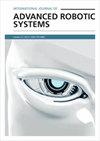Dynamic movement primitives based on positive and negative demonstrations
IF 2.1
4区 计算机科学
Q2 Computer Science
International Journal of Advanced Robotic Systems
Pub Date : 2023-01-01
DOI:10.1177/17298806231152997
引用次数: 1
Abstract
Dynamic motion primitive has been the most prevalent model-based imitation learning method in the last few decades. Gaussian mixed regression dynamic motion primitive, which draws upon the strengths of both the motion model and the probability model to cope with multiple demonstrations, is a very practical and conspicuous branch in the dynamic motion primitive family. As Gaussian mixed regression dynamic motion primitive only learns from expert demonstrations and requires full environmental information, it is incapable of handling tasks with unmodeled obstacles. Aiming at this problem, we proposed the positive and negative demonstrations-based dynamic motion primitive, for which the introduction of negative demonstrations can bring additional flexibility. Positive and negative demonstrations-based dynamic motion primitive extends Gaussian mixed regression dynamic motion primitive in three aspects. The first aspect is a new maximum log-likelihood function that balances the probabilities on positive and negative demonstrations. The second one is the positive and negative demonstrations-based expectation–maximum, which involves iteratively calculating the lower bound of a new Q-function. And the last is the application framework of data set aggregation for positive and negative demonstrations-based dynamic motion primitive to handle unmodeled obstacles. Experiments on several typical robot manipulating tasks, which include letter writing, obstacle avoidance, and grasping in a grid box, are conducted to validate the performance of positive and negative demonstrations-based dynamic motion primitive.基于正负演示的动态运动原语
在过去的几十年里,动态运动原语一直是最流行的基于模型的模仿学习方法。高斯混合回归动态运动原语是动态运动原语族中一个非常实用和突出的分支,它利用了运动模型和概率模型的优点来处理多次演示。由于高斯混合回归动态运动原语只从专家演示中学习,并且需要完整的环境信息,因此它无法处理具有未建模障碍的任务。针对这一问题,我们提出了基于正、负演示的动态运动原语,引入负演示可以带来额外的灵活性。基于正负演示的动态运动原语从三个方面扩展了高斯混合回归动态运动原语。第一个方面是一个新的最大对数似然函数,它平衡了正面和负面演示的概率。第二种是基于正和负演示的期望-最大值,它涉及迭代计算新Q函数的下界。最后是基于动态运动原语处理未建模障碍物的正负演示数据集聚合应用框架。在几个典型的机器人操纵任务上进行了实验,包括写信、避障和在网格框中抓握,以验证基于动态运动原语的正负演示的性能。
本文章由计算机程序翻译,如有差异,请以英文原文为准。
求助全文
约1分钟内获得全文
求助全文
来源期刊
CiteScore
6.50
自引率
0.00%
发文量
65
审稿时长
6 months
期刊介绍:
International Journal of Advanced Robotic Systems (IJARS) is a JCR ranked, peer-reviewed open access journal covering the full spectrum of robotics research. The journal is addressed to both practicing professionals and researchers in the field of robotics and its specialty areas. IJARS features fourteen topic areas each headed by a Topic Editor-in-Chief, integrating all aspects of research in robotics under the journal''s domain.

 求助内容:
求助内容: 应助结果提醒方式:
应助结果提醒方式:


